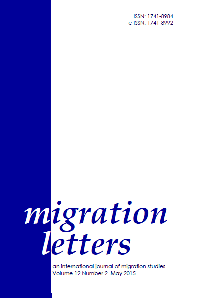Know your enemy: How repatriated unauthorized migrants learn about and perceive anti-immigrant mobilization in the United States
Know your enemy: How repatriated unauthorized migrants learn about and perceive anti-immigrant mobilization in the United States
Author(s): Daniel E. Martinez, Matthew WardSubject(s): Migration Studies
Published by: Transnational Press London
Keywords: Unauthorized; migrant; nativism; migration; anti-immigrant;
Summary/Abstract: Recently scholars have turned their attention towards a growing anti-immigrant movement in the United States. In particular, residents called ‘minutemen’ have garnered attention for their vigilante patrols of the U.S.-Mexico border. Yet, there remains an absence of rigorously collected data from the unauthorized migrants they target. Filling this void, we draw on original survey data from Wave 1 of the Migrant Border Crossing Study (MBCS) and address three questions: Among repatriated unauthorized migrants who have heard of minutemen, from where do they get their information? What qualities or characteristics do unauthorized repatriated migrants ascribe to minutemen? And, finally, how closely do these perceptions align with common tropes about minutemen? In so doing, we detail the composition of repatriated unauthorized migrants’ knowledge networks and the role these played in diffusing knowledge about minutemen. Additionally, we illuminate differences in the content of the minuteman-related information these networks diffuse. We find that respondents relied heavily on media outlets in the United States and Mexico to obtain information about minutemen. Social networks and the crossing experience itself mattered to a much lesser extent. Interestingly, repatriated unauthorized migrants were mixed in their perceptions of exactly who minutemen were, and migrants varied greatly in their reliance upon dominant tropes to identify minute-men. We conclude with implications and directions for future research.
Journal: Migration Letters
- Issue Year: 12/2015
- Issue No: 2
- Page Range: 137-151
- Page Count: 15
- Language: English

